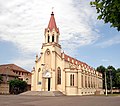Our Lady of Navigators | |
|---|---|
 Statue of Our Lady of Navigators at the Our Lady of Navigators church, Porto Alegre, Brazil | |
| Venerated in | Roman Catholic Church |
| Feast | 2 February |
| Attributes | Blessed Virgin Mary held by angels, Infant Jesus holding an anchor, mantle, jewelry, crown, halo of stars |
| Patronage | Navigators, sailors, protection from storms |
| |
| Part of a series on the |
| Mariology of the Catholic Church |
|---|
 |
| |
Our Lady of Navigators also known as Our Lady of Seafarers (Nossa Senhora dos Navegantes in Portuguese) is a devotional title given to the Virgin Mary by Roman Catholics. It is a widespread devotion in South America, especially in Brazil, where her holy day is celebrated on 2 February, it is an official holiday on the city of Porto Alegre. Several churches in Brazil are dedicated to Our Lady of Navigators. [1] [2] [3]






